For Consultation, get in touch at:
+91 9163560026 / +91 9007000512 (From 9:00 a.m. to 9:00p.m.)
Overview of Knee
Knee is considered to be the largest joint of a human body. As known to all of us it joints the lower leg with the thigh and comprises of two articulations. The first articulation is located between tibia and femur whereas the second one is found between the patella and femur. Being a central hinge point knee allows the body to complete the tasks of flexion as well as extension. It is a trocho-ginglymus mobile in nature and permits a slight lateral and medial rotation too. Since the weight of whole body depends on knee joints to a great extent it is very important to take care of the same. Even if a small injury or pain is experienced the same would need to get checked by the expert professional. However, in this context it is important to know the problems that may arise as far as the knee joints, ankles and braces are concerned.
Knee parts - Bones and Cartilages, Tendons, Muscles, Ligamen
How do the knees work?
The knee is meeting point of the bones of the upper leg with that of the lower leg. Knees allow hinge like movement that makes human body strong and stable enough to bear the weight of the body. Knees improve the flexibility of the leg joints and also make the motions like walking, crouching, running, turning or jumping easier.
Quick Contact
Mobile: +91 98310 61250
Email:
vikash.kapoor@medicasynergie.in
directormios@medicasynergie.in
For Consultation, get in touch at
+91 9163560026 / 9007000512
(From 9:00 a.m. to 9:00 p.m.)

